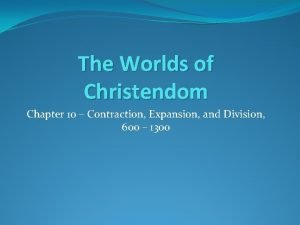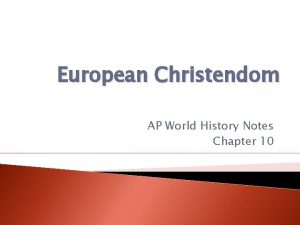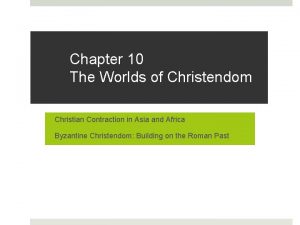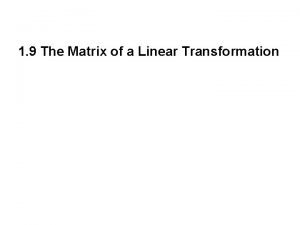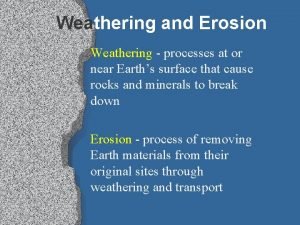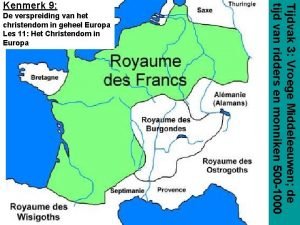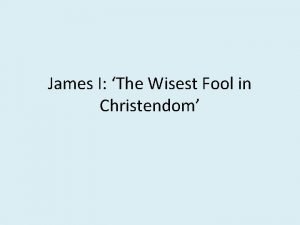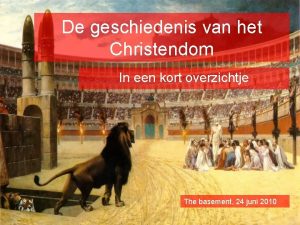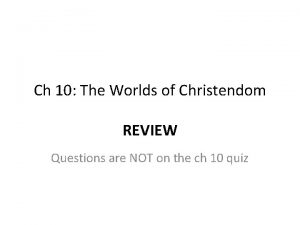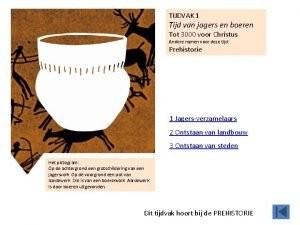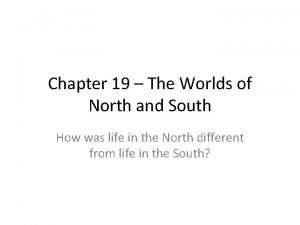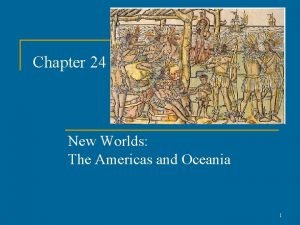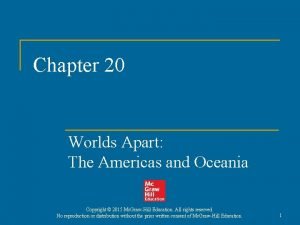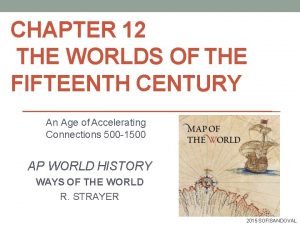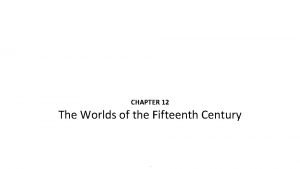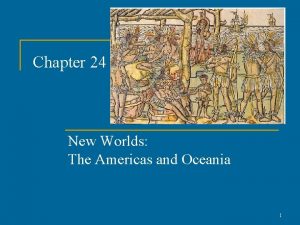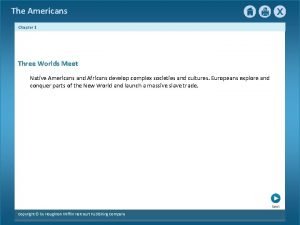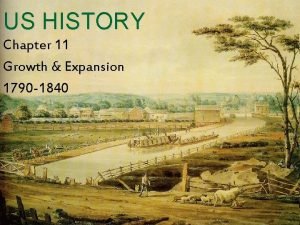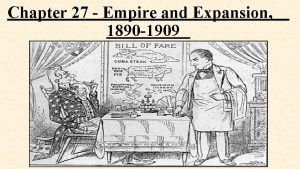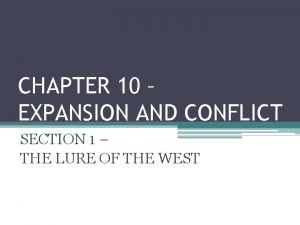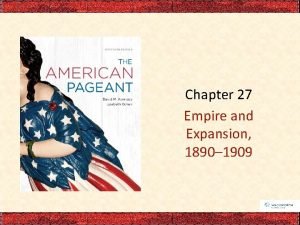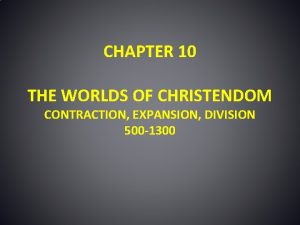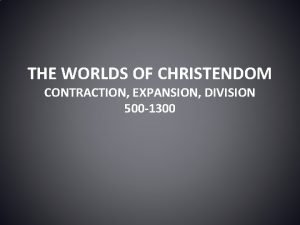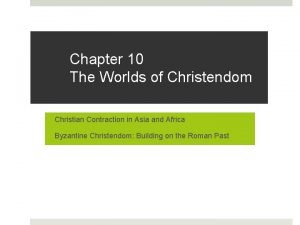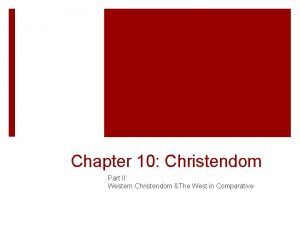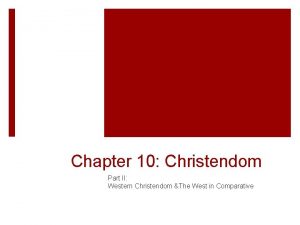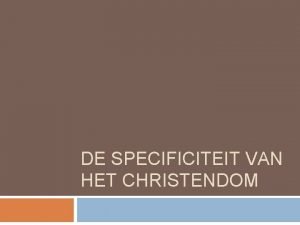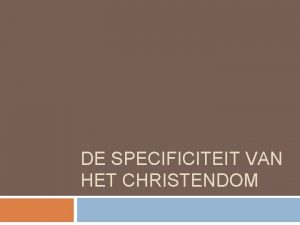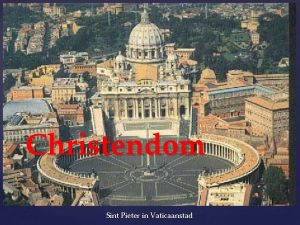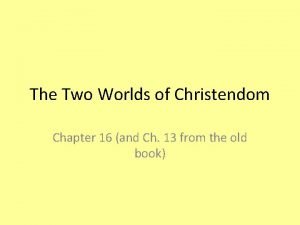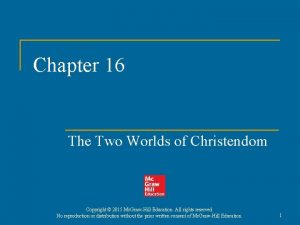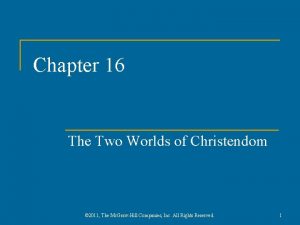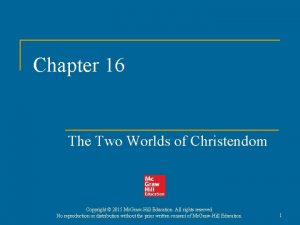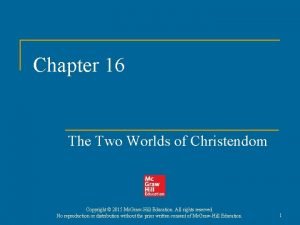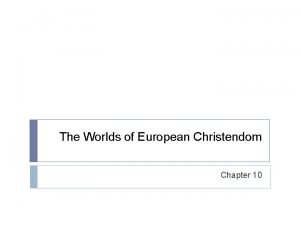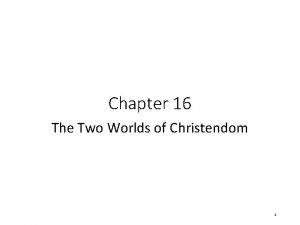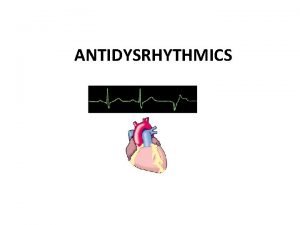The Worlds of Christendom Chapter 10 Contraction Expansion































- Slides: 31

The Worlds of Christendom Chapter 10 – Contraction, Expansion, and Division, 600 – 1300

Asian Christianity � While Christianity had spread through much of North Africa and the Middle East, the unexpected rise of Islam meant the end of some Christian communities, especially in the Arabian Peninsula. However, in Syria, Jerusalem, and Armenia, Christian leaders negotiated agreements with the Islamic forces. � In Syria, Iraq, and Persia, a Church of the East, the Nestorians, found accommodation with Islamic rulers. In China, the Nestorian Christians adapted to Chinese culture. From the 600 s to the mid 800 s, this church survived but this changed when the Tang dynasty moved against all foreign faiths. � The Mongols were tolerant regarding religion, and some even converted. Others preferred Christianity to Buddhism and Islam as they wanted to eat meat and drink alcohol.

African Christianity �Christians in Egypt developed their own interpretations of the life of Jesus and their own Coptic language for worship. They were tolerated by Arab rulers until violent campaigns against them in the mid-fourteenth century. �Further south in Nubia, Christianity flourished for some 600 years. Many political leaders also held religious office. By 1500, pressure from Egypt, conversions, and Arab migrations spelled the end of this community. �In the Ethiopian highlands, a unique form of Christianity developed and still survives. Isolated from its Islamic neighbors, the faith followed its own course without contact with other Christian churches.

Split of the Roman Empire

Byzantine Christendom �A continuation of the Roman Empire. �No clear beginning (Constantinople founded in 330 C. E. ) �Formal Division of eastern and western Roman Empire in the late 4 th century. �Rome falls in 476 C. E. and the eastern half survived for another thousand years.

Eastern Advantages �Wealthier and more urbanized. �More defensible capital (Constantinople). �Shorter frontier to guard. �Access to the Black Sea; command of eastern Mediterranean �A stronger army, navy, and merchant marine. �They continued Roman infrastructure. �A conscious effort to preserve Roman ways.

Map of the Byzantine Empire

The Byzantine State �Remained powerful until the 1200 s. �Politically authority remained centralized. �The imperial court resembled ancient Persian splendor. �Emperor ruled as “god’s representative on earth. ” �Government bureaucrats focused on tax collection, maintaining order, and suppressing revolts. �The Byzantine Empire fell in 1453 when the Ottoman Turks sacked Constantinople.

The Byzantine Church and Christian Divergence �*Caeseropapism – church and state tightly connected: -the emperor was head of orthodox church and state. * �Legitimized imperial rule. �Cultural orthodox (right-thinking) identity. �Differences in Latin (Roman Catholic) Christianity: -priest’s celibacy. -shaving. -the Pope as head of church. �Schism of 1054 – mutual excommunication. �Crusades begin in 1095 – worsen the rift.

Byzantium and the World �Intense interaction in Europe and Asia. �Byzantium continued the long-term Roman struggle against the Persians. �“Greek Fire” (flamethrower) helped keep Byzantium standing so long. �Sitting at one of the key hinges of trade, the empire became very wealthy. Its coins were used as currency and even jewelry throughout the Mediterranean. �Byzantine libraries preserved Greek texts. These texts would later be introduced to the West. �The Byzantines spread their culture northwards into Slavic lands.

Image of “Greek Fire”

The Conversion of Russia �Most important conversion was that of Prince Vladimir of Kiev in 988. �Orthodoxy transformed state of Rus; became central to Russian identity. �The Rus borrowed extensively from Byzantium, including the use of icons, architectural style, a monastic tradition, and imperial control of the church. �Moscow declared itself to be the “third Rome, ” assuming role of protector of Christianity after fall of Constantinople.

Western Christendom �On the periphery of the world: -far removed from trade routes. �Geography made political unification difficult. �Western Europe would not occupy a central location in the global network until 1500. �Extensive coastlines, river systems, moderate climate, rainfall, and fertile soils allowed western Europe to have a productive agriculture and sustain a growing population.

Map of the Carolingian Empire

Political Life in Western Europe �Recall: Rome collapsed in 476 C. E. -Odoacer overthrew the last Roman emperor. -Rome became bankrupt. �Large-scale centralized rule had vanished. �Population fell by 25% due to warfare and disease. �Less land to cultivate. �Less movement as roads deteriorated. �Decline in literacy. �Urban-Rural migration pattern.

Political Life in Western Europe (Cont’d) �Many Germanic peoples were already Romanized: -many served in the Roman Army. �Adoption of Roman law system. �Efforts to re-create the old Roman imperial system: -Charlemagne (r. 768 -814) – Carolingian Empire. -Otto I of Saxony (r. 936 -973) – Holy Roman Empire. �Attempts failed to re-create a “Roman imperial authority” due to quarreling principalities.

Feudalism Chart

Society and the Church �New Kingdoms: -highly fragmented; birth of feudalism. -great local variation. -landowning warrior elite possessed most power. �Social Hierarchies -serfdom replaces slavery. -life on the manor (isolated landed estates). �Stability was found in the Roman Catholic Church.

Society and the Church (Cont’d) �The Church became very wealthy. �Conversion of most of Europe: -Top-Down Conversion. -considerable cultural accommodations. -amulets, sacred wells, and festivals were absorbed by Christianity. �Investiture Conflict – Who appoints the pope and/or bishops?

Manor Map

Europe in the High Middle Ages

Accelerating Change in the West � After centuries of Muslim, Viking, and Magyar attacks, security settled into Europe following 1000. � High Middle Ages (1000– 1300): an era of economic, political, and demographic growth (35 to 80 million). � Essential to economic growth was the revival of trade routes. � Substantial growth in the cities saw a specialization of labor and professions (Guilds) � Some kingdoms in the northwest developed large land bases while commercially vibrant city-states characterized Italy and numerous small states dominated the German lands. � Initially, economic growth opened up opportunities for women. However, men re-asserted control.

Map of the Crusades

The Crusading Tradition �These series of “holy wars” began in 1095: -wars at God’s command, authorized by the pope, for which participants received an indulgence (release from penalty for confessed sins and material benefits). -amazingly popular; religious wars at their core. -most famous Crusades aimed to regain Jerusalem and other holy places. -displayed Europe’s growing organizational ability.

The Crusading Tradition (Cont’d) �Tens of thousands of Europeans made contact with the Islamic world: - stimulated demand for Asian goods. - learned how to produce sugar using slave labor. - Muslim/Greek scholarship entered Europe. - hardened cultural barriers. - deepened the Catholic/Orthodox divide. - development of anti-Semitism in Europe. - memory of the Crusades still affects dealings between Western civilization and Islam today. �Christians did not regain much land at all by 1291.

Crusades Propaganda

The West in Comparative Perspective �Western Europe was less developed than Byzantium, China, India, or the Islamic world. �Muslims regarded Europeans as barbarians. �Europeans recognized their own backwardness. �Marco Polo and other merchant-travelers were willing to make the long journeys to the east (China), exchanging with and borrowing from more advanced civilizations. �European economies re-connected with the Eurasian trading system.

Europe Borrows from the East �Europeans welcomed scientific, philosophical, and mathematical concepts from the Arabs, classical Greeks, and India: -i. e. the compass, papermaking; gunpowder. �Europe developed a passion for technological innovation: -the caravel, carracks; new cartography (astrolabe). �By 1500, Europe had caught up with China and the Islamic world and surpassed them in some areas.

Pluralism in Politics �Competing States (ex: England, Spain; France): -led to war; technological developments. -paved the way for capitalism (industry). -kings less powerful than those in the east. -parliaments developed (nobles wanted power). �The three-way political struggle allowed merchants a great deal of independence and autonomy.

Reason and Faith �Intellectual tension between reason and faith. �Intellectual life flourished after 1000: -University Schools, Humanism. -development of “natural philosophy”(study of nature). -applied reason to law, medicine, and nature. -search for Greek classical texts (Aristotle). �The Byzantines had many Greek texts, but were not interested in natural philosophy. �In the Muslim world, many Greek texts were translated into Arabic, but debates arose regarding whether reason was an aid or a threat to faith.

Cathedral School in Europe
 Chapter 10 the worlds of christendom notes
Chapter 10 the worlds of christendom notes Chapter 10 ap world history notes
Chapter 10 ap world history notes The worlds of christendom
The worlds of christendom Fusiform smooth muscle
Fusiform smooth muscle Worlds together worlds apart 4th edition
Worlds together worlds apart 4th edition Horizontal contraction/expansion matrix
Horizontal contraction/expansion matrix Expansion and contraction weathering
Expansion and contraction weathering Expansion and contraction
Expansion and contraction Thermal expansion and contraction examples
Thermal expansion and contraction examples De verspreiding van het christendom in europa
De verspreiding van het christendom in europa Wisest fool in christendom
Wisest fool in christendom De geschiedenis van het christendom
De geschiedenis van het christendom In comparison to byzantium latin christendom
In comparison to byzantium latin christendom De verspreiding van het christendom in geheel europa
De verspreiding van het christendom in geheel europa Jodendom christendom
Jodendom christendom Lesson 19 the worlds of north and south
Lesson 19 the worlds of north and south New worlds the americas and oceania
New worlds the americas and oceania New worlds the americas and oceania
New worlds the americas and oceania Worlds apart the americas and oceania
Worlds apart the americas and oceania Chapter 12 worlds of the 15th century
Chapter 12 worlds of the 15th century The worlds of the fifteenth century
The worlds of the fifteenth century Chapter 24 the americas and oceania
Chapter 24 the americas and oceania Chapter 1 three worlds meet answer key
Chapter 1 three worlds meet answer key Chapter 21 temperature heat and expansion
Chapter 21 temperature heat and expansion Chapter 15 temperature heat and expansion
Chapter 15 temperature heat and expansion Lesson 2 moving west
Lesson 2 moving west Chapter 21 temperature, heat and expansion answer key
Chapter 21 temperature, heat and expansion answer key Chapter 27 empire and expansion
Chapter 27 empire and expansion Chapter 10 expansion and conflict worksheet answers
Chapter 10 expansion and conflict worksheet answers Chapter 21 temperature, heat and expansion answer key
Chapter 21 temperature, heat and expansion answer key Chapter 12 territorial and economic expansion
Chapter 12 territorial and economic expansion Chapter 27 empire and expansion
Chapter 27 empire and expansion
